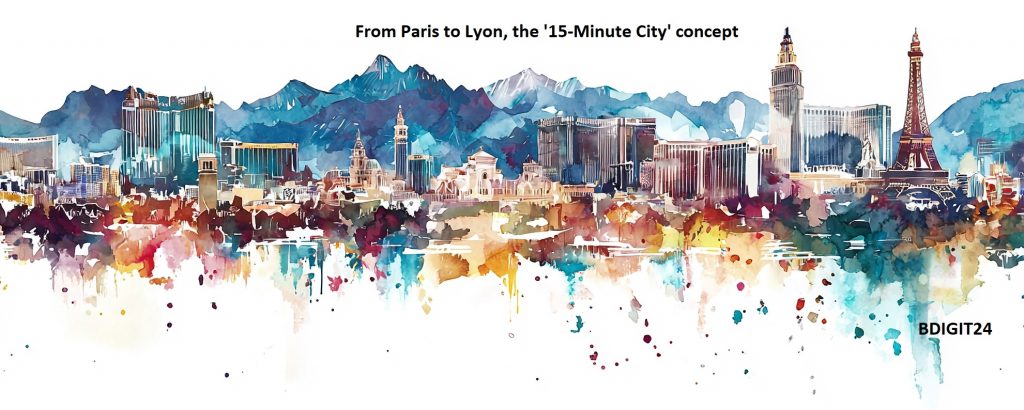From Paris to Lyon, the ’15-Minute City’ concept is transforming neighborhoods and challenging traditional urban planning
The concept of the “15-minute city” has taken root in French urban planning, sparking a global movement that reimagines city life. This innovative approach aims to create neighborhoods where residents can access essential services and amenities within a short walk or bike ride, fostering local economies, reducing car dependency, and enhancing quality of life.
The Birth of the 15-Minute City
The 15-minute city concept, championed by Paris Mayor Anne Hidalgo, has become the backbone of a new urban plan in the French capital. This human-centric design emphasizes creating self-sufficient neighborhoods where daily necessities are easily accessible, promoting walking, cycling, and public transport use.
In Paris, the implementation of this concept has already shown promising results. An impressive 94% of Parisians now live within a five-minute walk of a bakery, showcasing the city’s potential for hyper-local living. This success has inspired other French cities to follow suit, with the model gaining traction across the country.
Success Stories and Challenges
Paris: Leading the Way
Paris has emerged as a pioneer in implementing the 15-minute city concept, with 50 such neighborhoods already in operation. The city’s efforts have focused on:
- Expanding bike lanes and pedestrian zones
- Promoting mixed-use development
- Enhancing public spaces and green areas
These initiatives have not only improved accessibility but also contributed to reducing carbon emissions and promoting healthier lifestyles among residents.
Lyon: Embracing Sustainable Mobility
Lyon has also embraced the 15-minute city model, focusing on sustainable mobility solutions. The city has:
- Implemented an extensive bike-sharing system
- Created car-free zones in the city center
- Invested in public transportation infrastructure
These efforts have resulted in a significant reduction in car usage and improved air quality in the city.
Economic Impacts on Local Businesses
The shift towards 15-minute cities has had a notable impact on local economies:
- Increased foot traffic: With more people walking and cycling, local businesses have seen a boost in customer visits.
- Diversification of local services: The demand for nearby amenities has led to a more diverse range of businesses in residential areas.
- Job creation: The focus on local economies has created new employment opportunities within neighborhoods.
- Resilience during crises: During the COVID-19 pandemic, local shops in Paris demonstrated surprising resilience as commutes dropped, highlighting the strength of decentralized commerce.
However, the rise in property values in these desirable neighborhoods has raised concerns about gentrification and the need for affordable housing policies.
Technology Enabling the 15-Minute City
Advancements in technology play a crucial role in realizing the 15-minute city vision:
- Aerial imagery and location intelligence: These tools provide urban planners with detailed site surveys and 3D modeling capabilities, essential for redesigning neighborhoods.
- Smart mobility solutions: Apps for bike-sharing, public transport, and walking routes help residents navigate their 15-minute radius efficiently.
- Remote work technologies: The widespread adoption of remote work supports the decentralization of workspaces, reducing the need for long commutes.
- IoT and smart city infrastructure: Connected devices and sensors help optimize city services and improve the overall urban experience.
Challenges and Future Outlook
While the 15-minute city concept has shown promise, it faces several challenges:
- Retrofitting existing infrastructure: Adapting older urban areas to the 15-minute model can be complex and costly.
- Ensuring inclusivity: Measures must be taken to prevent gentrification and maintain affordable housing options.
- Balancing local and city-wide needs: While promoting local living, cities must also maintain connections between different neighborhoods.
Despite these challenges, the 15-minute city model continues to gain momentum in France and beyond. As more cities adopt this approach, we can expect to see a transformation in urban living, with a focus on sustainability, community, and improved quality of life.
The rise of 15-minute cities in France represents a significant shift in urban planning philosophy. By prioritizing accessibility, sustainability, and local economies, this model offers a promising solution to many of the challenges faced by modern cities. As French cities continue to refine and implement this concept, they are setting an example for urban centers worldwide, paving the way for a more livable and sustainable urban future.
#15MinuteCity #UrbanPlanning #SustainableCities #FrenchInnovation


